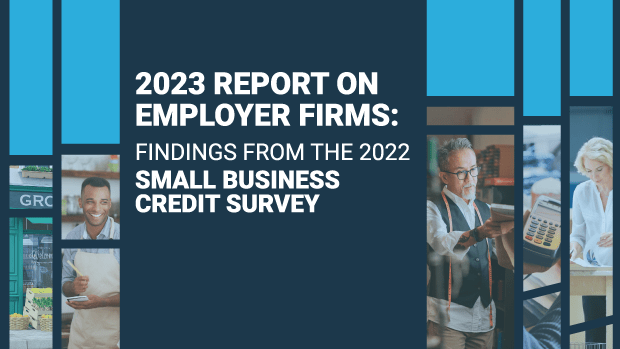Every fall, thousands of small business owners tell the Federal Reserve about their experiences over the past year through the Small Business Credit Survey (SBCS). Their responses become data that represent the 33.2 million small businesses across the United States. The March 2023 SBCS report on firms with employees uncovered promising signs that some trends are returning to prepandemic norms. It also surfaced persistent challenges and signals of uncertainty.
National data matter and so do the individual experiences that underlie the data. With this in mind, the takeaways below summarize what’s changing and what’s not for small businesses. We’ve also included some direct quotes from survey respondents to add perspective.
Quotes are lightly edited for readability, to preserve anonymity, or both. All quotes come from employer firms and represent the views of the individual.

Revenue, employment, and profitability improvements
Overall, small business owners with employees experienced business growth through 2022, and an increasing share were profitable. But when asked about their expectations for the coming year, small business owners in general were less optimistic than in past years, with a smaller share anticipating revenue or employment growth.
“The environment of business economics has changed since COVID-19 and does not seem to be rebounding from the negative effects. Combine those effects with a much higher cost of operating due to inflation and higher wages paid, [and] small business[es] like us have struggled to get back to pre-COVID conditions, with no clear forecast going forward. In our [years] of doing business, we never had to deal with flat sales, lost revenues, and very thin working capital.”
Leisure and hospitality business in New Jersey
“The condition of my business is good, [but] the economic outlook for the next 1 to 3 years is poor, [and] our customer calls have decreased.”
Professional services and real estate firm in Washington
“I feel very optimistic about the current outlook. While we’re prepared to experience a brief and minor downturn in volume, our current sense is that our sales will continue to grow through 2024.”
Nonmanufacturing goods production and associated services business in Pennsylvania
Hiring and the supply chain challenges
Almost every employer firm in the survey experienced at least one operational or financial challenge in 2022. Supply chain challenges, difficulty hiring and retaining staff, and rising costs were particularly widespread.
“Hiring dependable, quality workers is very difficult. Sales are strong, but, with our reduced staffing, our lead times are now months. In the past, [lead time] was 2 weeks. We are losing customers because of it. Extreme inflation in raw material, transportation, and labor costs are crippling small businesses.”
Manufacturer in Pennsylvania
“Many businesses are hit by post-pandemic fallout. For instance, we are remodeling contractors. Our market appears strong to observers. However, supply chain issues are restricting production, and cost escalation is chasing away prospective clients.”
Nonmanufacturing goods production and associated services business in Texas
Financing sources and repayment worries
When asked about the funding sources they used over the past five years, small business owners were more likely to use personal and government sources than funding from financial institutions. Among firms that relied on government sources of funding, some received forgivable loans or grants from programs such as the Small Business Administration’s (SBA) Paycheck Protection Program (PPP), but others noted struggles with long-term debt from sources such as the SBA’s Economic Injury Disaster Loan (EIDL) program.
“If it wasn’t for personal financing, friends and family financing, and grants, we would not be in business.”
Nonmanufacturing goods production and associated services business in Hawaii
“Our support has come almost exclusively from bootstrapping, privileged access to investment and private loans from friends and family, and unparalleled support from our community.”
Manufacturer in Louisiana
“Our SBA loan that was secured during the pandemic is scheduled to begin repayment next month. If our sales continue to decline, we might find it difficult to repay our loan.”
Leisure and hospitality business in California
Fully approved financing increased from 2021 but remains lower than in 2019
As pandemic-related funding programs ended, the share of employer firms that applied for a loan, line of credit, or cash advance rebounded to prepandemic levels. But the share of employer firms that were then approved for the full amount of funding they sought has not rebounded, suggesting there are unmet funding needs.
“Business financing, on favorable terms and from a reputable institution (that is, a bank), is incredibly difficult, document-intensive, and tricky to get. The requirement of a personal guarantee in virtually all situations, to me, makes it personal financing, not business.”
Leisure and hospitality business in Wisconsin
“It was one thing to weather the pandemic, but we made it through. However, we are stuck in no man’s land—too small to be big and too big to be small. We have always paid our loans on time (sometimes early) and never had an issue, and we have been in business for [many] years. We are a safe credit risk, but we still could not get the funding that we need. The lack of funding is killing my business because I cannot grow to meet demand as quickly as possible. We need patient money with favorable interest rates with lower monthly repayment amounts, and that is not the current lender environment.”
Professional services and real estate firm in Virginia
“Financing has been readily available but has become more expensive.”
Healthcare and education business in Tennessee

Detailed findings for employer firms are available in the 2023 Report on Employer Firms: Findings from the 2022 Small Business Credit Survey. As findings from the 2022 SBCS are released throughout 2023, you can find the data at fedsmallbusiness.org.
About the Small Business Credit Survey
The Federal Reserve Small Business Credit Survey is an annual survey of firms with fewer than 500 employees. These types of firms represent 99.7% of all employer establishments in the United States. Respondents are asked to report information about their business performance, financing needs and choices, and borrowing experiences. Responses to the SBCS provide insights on the dynamics behind lending trends and shed light on various segments of the small business population. The results are weighted to reflect the full population of small businesses in the United States. The SBCS is not a random sample; results should be analyzed with awareness of potential biases that are associated with convenience samples.
Fielded September through November 2022, the most recent SBCS was the third conducted since the COVID-19 pandemic began in early 2020. The 2022 SBCS yielded nearly 14,000 responses from a nationwide convenience sample of small firms across all 50 states and the District of Columbia, including 7,864 responses from employer firms with 1–499 full- or part-time employees. The remaining responses represent nonemployer firms, or those with no employees other than the owner(s). A separate report on nonemployer firms is coming later this year.


